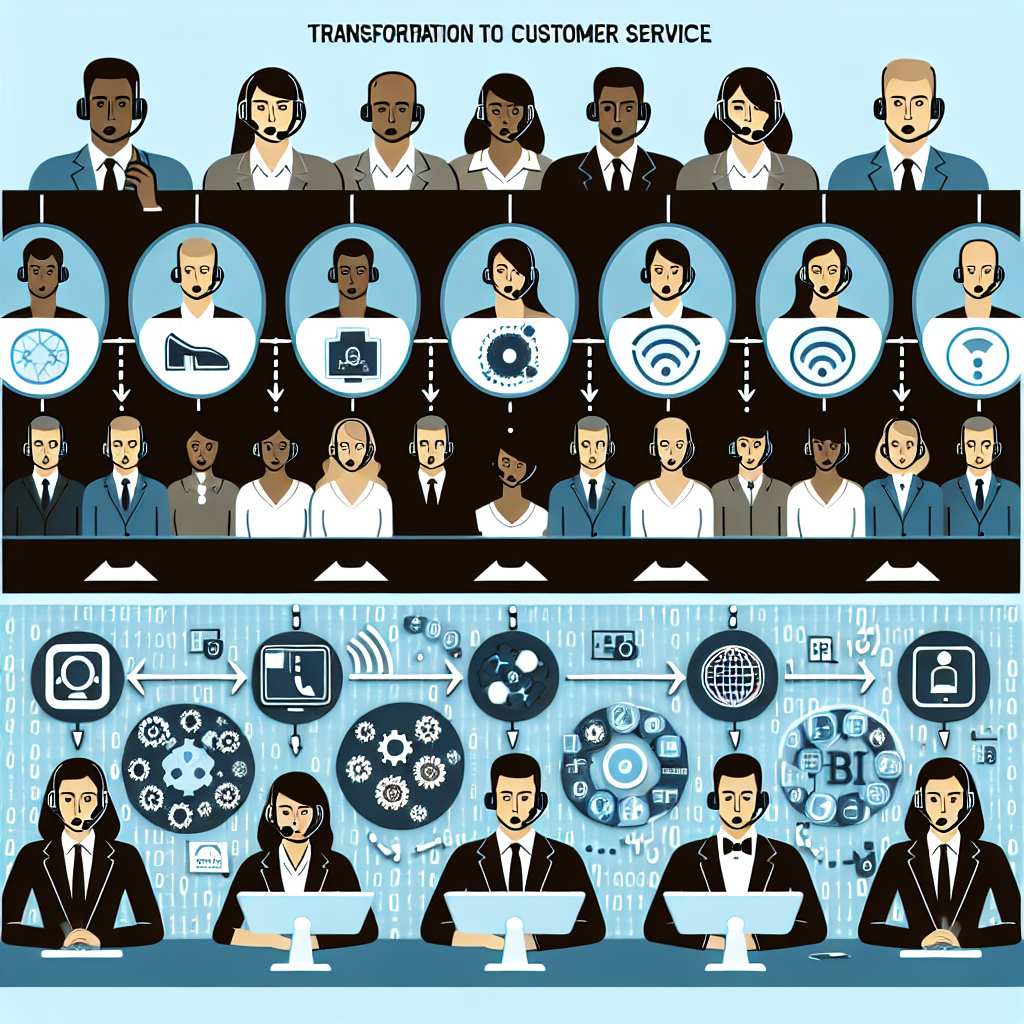
In the evolving world of customer service, AI-driven call deflection has emerged as a fundamental aspect worthy of attention. Essentially, this technology guides and redirects customers to efficient, automated digital channels during service interactions, typically when it's more appropriate or beneficial for both the customer and the service provider.
An introduction to this concept would be incomplete without acknowledging the sheer power of Artificial Intelligence in transforming how businesses interact with their customers. The move to digital platforms in customer-centric operations is more pronounced, now more than ever.

Let's delve into how this implementation works. When implemented, AI analyzes the initial interaction from a customer, discerning the nature of their request or complaint. If the AI system determines that the customer's needs can be better served via a digital channel, it will subtly guide them to the appropriate platform. This could be a self-service portal, live chat, email, or even a digital assistant.
The influence and effectiveness of AI-driven call deflection technology lie in its ability to recognize and adapt to individual customer behavior. It understands the customer's history, preferences, and even the emotional context of their calls. This allows for a personalized, seamless journey, often resulting in quicker resolutions and improved customer satisfaction.
Adopting AI-driven call deflection can lead to significant benefits for businesses. Examples include reductions in call center volumes, operating costs, and improved customer relationship management. More so, AI-powered call diversion could just be the start: this AI deployment can be an integration point for further enhancing customer service operations.
With businesses vying for leading-edge solutions to augment customer service, AI-driven call deflection is at the forefront. Its potential for improving the efficiency, effectiveness, and overall customer experience is, without doubt, an exciting prospect.
As the digital age evolves, so does the inclination towards automating customer service processes with technologies such as AI-Driven Call Deflection. The AI call deflection strategy is engineered to reduce the burden on human agents and direct customers towards more efficient, digital channels when appropriate, subsequently augmenting customer service experiences.
So, how does AI call deflection work? The AI system is integrated with an organization's customer service system to ensure seamless process execution. It uses machine learning algorithms to understand the nature and the complexity of the customer's query. Based on the analysed data, the AI system determines whether the request can be solved via a digital platform or whether it necessitates human intervention.
The deflection to digital channels occurs when the AI system identifies a request that can be solved autonomously. For instance, if a customer inquires about a product's availability, the AI system can provide the answer by accessing the company's inventory data. If the query is more complex and requires empathy or in-depth insights, the AI directs the call to a human agent. This smart division of labor facilitates a more effective customer service process, freeing up human agents to handle more intricate and valuable queries.
Key to the success of AI call deflection is the ability to learn and adapt from every interaction. It employs machine learning to continuously update its ability to categorize and process queries, enabling it to make more precise decisions with each interaction, ultimately improving customer service efficiency over time.
To summarize, AI call deflection equips businesses to guide customers to appropriate channels, significantly enhancing the efficiency and effectiveness of their customer service. The blend of human and artificial intelligence drives a finely tuned, customer-centric approach, ensuring that customers get the assistance they need in the most suitable, efficient manner possible.
As businesses continue to adapt and evolve in the digital era, the utilization of AI-driven call deflection techniques are becoming of critical importance in optimizing customer engagement and support. Of course, any successful application requires thoughtful and seamless integration with the platform's existing digital communication channels. This involves strategic planning, robust system integration, and ongoing customization and refinement based on real-time user interaction data.

The first step in effective integration involves establishing an effective coordination between the AI call deflection system and the existing channels such as Chatbots, Online FAQs, and customer support portals. This provides a convenient and smooth service experience, as customers are efficiently routed from initial contact through to resolution of their issue or query.
The second step goes beyond merely deflecting calls to actively guiding users towards the most appropriate digital platform for their needs. This requires a deep understanding of the user's intent, a level of insight that is furnished by AI's ability to analyze multitudes of data at high speed. Ultimately, this empowers businesses to deflect unnecessary calls while also providing timely, relevant assistance to their customers.
Finally, integration with existing digital platforms must be flexible and scalable. As customer needs and behaviors change, so too must the strategies for diverting and directing communication. The power of AI-driven call deflection comes from its ability to learn from every interaction, to constantly improve its predictive capabilities and provide data-driven recommendations for strategy refinement.
In conclusion, Integration of AI-driven call deflection with digital channels is a complex yet rewarding endeavour. With careful planning and application, businesses can leverage these systems to seamlessly direct customer communication to the most appropriate channels, improving the customer experience whilst reducing operational overheads.
In the rapidly evolving landscape of customer support, AI-Driven Call Deflection is carving its niche by offering multiple benefits, not just to the businesses but to the customers as well. The technology is making waves by guiding customers to more effective digital channels when traditional call support might fail to deliver.
One of the key benefits of adopting AI call deflection is the considerable cost savings it can offer a business. The average cost of a voice support call can range anywhere from $6-$12, while an AI-driven interaction costs mere pennies. According to Chatbots Life, the average interaction cost can drop by up to 70% using AI, a significant opportunity for budget allocation in other crucial areas.
This technology also brings about improved efficiency and better resource allocation within a business. Repetitive inquiries can be effectively handled by AI, freeing up support staff to deal with more complex queries. As reported by IBM Watson, AI can handle up to 80% of routine customer service questions, further affirming its contribution towards operational efficiency.
Lastly, AI call deflection contributes significantly to enhanced customer satisfaction. The technology ensures quick responses, 24/7 availability, and consistency in service, contributing to a better customer experience. A recent Salesforce survey found that 64% of consumers and 80% of business buyers said they expect companies to respond to and interact with them in real time. This accentuates the problem-solving potential and customer support role of AI.
In conclusion, AI-driven Call Deflection is a game-changer when it comes to driving efficiency, saving costs, streamlining resource allocation, and overall enhancing customer satisfaction. With its adoption, businesses have an opportunity to reshape conventional call support and offer an unprecedented customer support experience.
When it comes to transitioning customers from traditional call support towards more efficient digital channels, artificial intelligence (AI) has proven to be a highly effective tool. The use of **AI-Driven Call Deflection** allows businesses to redefine their entire customer experience, reducing waiting times, and increasing overall customer satisfaction. In this section, we will delve into real-world examples and case studies illustrating the tangible benefits and changes in company metrics.

One shining example is that of a global telecommunication company illustrated in a Zappix case study. The company implemented an AI-powered Visual IVR, which resulted in a meticulous redirection of customers towards digital channels. This strategy led to a *significant decrease in traditional voice calls*, a *noticeable uptick in customer satisfaction scores*, and a *remarkable reduction in operational costs*.
Another success story is of a leading logistics provider mentioned in a Telus International case study. The firm aimed to guide its customers to the website for simpler inquiries, preserving phone support for more complex issues. By deftly deploying *AI-Driven Call Deflection* in its strategy, the company was able to *decrease the time-to-resolution*, *enhance resource allocation*, and *improve customers' propensity towards self-service* significantly.
The United Kingdom's National Health Service (NHS) also embraced this AI-driven approach, as detailed in a case study by IBM. They utilized IBM's AI solutions to deflect routine calls to digital channels, thus helping the NHS *become more efficient*, *significantly reduce expenses*, and *improve the experience for millions of users*. This example further underscores the potential of *AI-Driven Call Deflection* in catering to a large, diverse user base.
A gradual but calculated shift towards digital channels through *AI-Driven Call Deflection* not only optimizes resources but also provides customers with choices and flexibility in how they interact with companies. As more organizations adopt this efficient practice, it is poised to become a standard in customer support workflows.
As digital transformation permeates every corner of businesses, AI-driven call deflection is becoming increasingly popular to meet customer needs in a more efficient manner. Shifting customer's queries to automated and digital channels can significantly reduce service duration and costs while enhancing customer satisfaction. Here are a few best practices to maximize the potential of AI call deflection in your organization.
Understanding Your Audience: To implement a successful call deflection strategy, understanding your customers' needs and behaviours is paramount. Analyze your customer data to identify common issues and determine the preferred communication channels for your target demographics. Learn more about customer segmentation using Machine Learning here.
Optimizing Existing Channels: Prior to adding new touchpoints, ensure that your existing customer service channels are optimized for best performance. A poorly functioning chatbot or a complex self-service portal can increase call volumes instead of deflecting them. Get insights on how to optimize your chatbot's performance.
Train Your AI: The success of AI call deflection largely depends on the intelligence of the AI. Training the AI with historic customer service data can help tailor the AI's responses to better serve customer queries. Examples of this can be found in Google's AI publications.
Monitor and Adapt: Implementing an AI call deflection strategy is not a one-time task. Continuously monitor the performance of your AI tools, seek customer feedback, and adapt your approach as required.
By incorporating these best practices, businesses can leverage AI-driven call deflection to guide customers to digital channels when appropriate, thereby increasing efficiency and customer satisfaction, while reducing costs.
Start your free trial for My AI Front Desk today, it takes minutes to setup!








